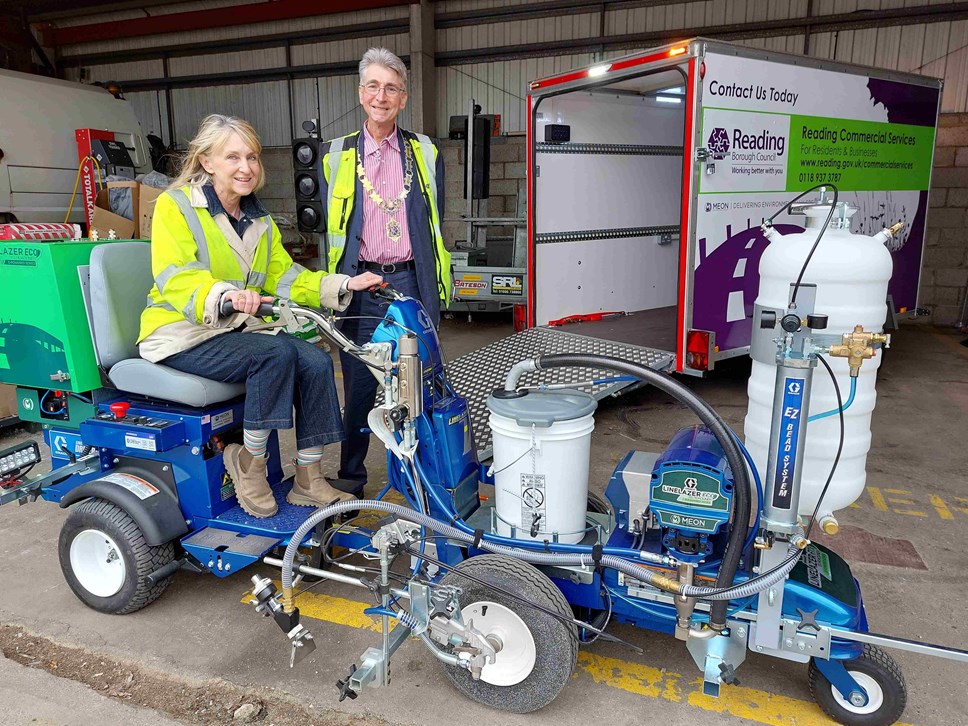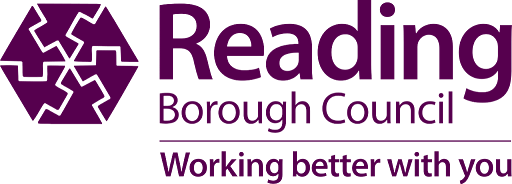
Council announces new electric line marking machine amongst range of road innovation measures
- New electric line marker will save money, upskill Council staff and help the environment
- Other innovations include new products to preserve roads and sensor technology for gritting
- LCRIG Chief Exec places Reading in top four most innovative authorities for highways
THE Council has unveiled the latest addition to its growing fleet of electric vehicles with a new fully electric road line marking machine.
The innovative new machine will not only help reduce costs and support Reading’s net carbon zero ambitions by using 60% less carbon, it will also mean more staff can improve their skills by being trained up to refresh Reading’s road markings.
The line marking machine was revealed at a visit last week from LCRIG, the Local Council Roads Innovation Group. Chief Executive Paula Claytonsmith was shown the machine and a range of other innovative solutions Reading Borough Council has introduced to improve the standard, efficiency and lifespan of its highways network, with the Mayor of Reading, Councillor Tony Page, and Lead Councillor for Environmental Services and Community Safety Karen Rowland, also present.
The electric machine replaces older diesel-powered vehicles and is able to do a full 8-hour shift on a single charge. It also uses a cold applied paint product rather than the usual hot paint material, which means line painting will be quieter, reduce carbon, last longer and be more environmentally friendly.
The Council also showcased new products being used to extend the life of roads and footways in Reading. These include Rhinophalt preservation, which was recently laid on the A33 junction with the M4 and on sections along the A33. Quicker, easier and less disruptive than a full road resurface which requires the top layer of the road being removed, Rhinophalt is a preservative layer applied to the existing road surface to extend the life of the road. A similar product is also being used on Reading’s footways, making it more cost effective and quicker to protect them while reducing our carbon footprint compared to traditional surfacing techniques.
The introduction of new temperature-sensor technology is another innovation which will benefits residents on Reading’s roads. With winter approaching, sensors are being installed and monitored around the borough to provide accurate, real time and localised temperature readings, ensuring surface gritting resources are concentrated more in areas that need it on any given occasion. The improved temperature data will ensure gritting only occurs where needed so blanket gritting doesn’t take place in areas of the borough which may not need to be treated. This will reduce waste, materials, costs and importantly the Council’s carbon footprint.
Sensor technology is also being introduced at traffic signals to produce more dynamic signalling which improve traffic flows and again reduce carbon production by helping to keep cars moving in Reading, as well as improving air quality.
LCRIG representatives also learned of the Council’s use of iTip handles, which allow operatives using wheelbarrows and other hand-held technology to be able to use them safely, minimising the risk of injury and strain for its operatives.
LCRIG Chief Executive Paula Claytonsmith said:
“The great thing about what Reading is doing is it is delivering innovation with its team and suppliers. The electric road marking vehicle will make a great difference and have a big impact from an environmental perspective. The iTip handles are a great way to look after the health of their operatives. We work with well over 100 highways authorities and Reading is up there in the top four for being an organisation that is improving delivery and using innovation”.
Karen Rowland, Lead Councillor for Environmental Services and Community Safety at Reading Borough Council, said:
“The introduction of these new innovations is what residents can expect from our award-winning highways team here in Reading. A genuine focus of this team on the Council’s net zero ambitions is the impetus for driving forward these innovations, but the benefits don’t just stop there.
"Bringing more highway operations in house, such as line marking with the new electric vehicle, means we are able to respond quicker to residents’ requests. Making savings by reducing the reliance on contractors and providing opportunities for our staff to upskill along their career paths are further benefits. This team is constantly bringing forward new ideas that, when pieced together, really begin to turn the page on ensuring our transport routes are at the cutting-edge of innovation in the race to meet this Council’s net zero ambitions.”
